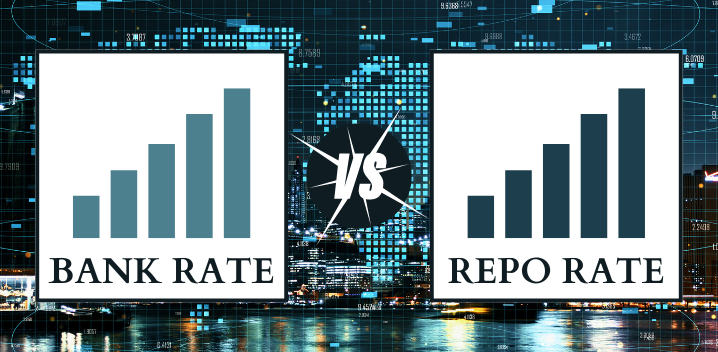Bank Rate vs Repo Rate
5paisa Research Team
Last Updated: 19 Apr, 2024 03:53 PM IST

Content
- What Is The Repo Rate?
- What Is The Bank Rate?
- Differences between Repo Rate and Bank Rate
- Collateral
- Bank rate vs repo rate: Main difference
- What Are The Current Repo Rate And Bank Rate 2023?
- Conclusion
Bank Rate Vs Repo Rate are the popular rates computed for borrowing or lending activities by commercial and central banks. They are nothing but the lending rates at which the central bank funds financial institutes and commercial banks.
While these rates have sheer differences, one thing that's common is that both are short-term rates. They are sued for controlling cash flows in a market. Most often, they are mistaken as one, but there are a few differences, which this post has compiled.
Before you delve into the details of their significance and definitions, you need to comprehend what they are. On that note, the repo rate is the rate at which RBI lends to commercial banks by buying securities. Contrarily, the bank rate is the lending rate at which commercial banks borrow from RBI without securities. Get an insight into the intricate details of these two terms from the given pointers.
More About Generic
- What is a Virtual Payment Address (VPA) in UPI?
- Best Swing Trading Strategies
- What Is FD Laddering?
- What Credit Score is Needed to Buy a House?
- How to Deal with Job Loss?
- Is 750 a good credit score?
- Is 700 a Good Credit Score?
- What is Impulse Buying?
- Fico Score vs Credit Score
- How to remove late payments from your credit report?
- How to Read Your Credit Card Statement?
- Does Paying Car Insurance Build Credit?
- Cashback vs Reward Points
- 5 Common Credit Card Mistakes to Avoid
- Why Did My Credit Score Drop?
- How to Read a CIBIL Report
- How Long Does It Take to Improve Credit Score?
- Days Past Due (DPD) in CIBIL Report
- CIBIL Vs Experian Vs Equifax Vs Highmark Credit Score
- 11 Common Myths about CIBIL Score
- Tactical Asset Allocation
- What is a Certified Financial Advisor?
- What is Wealth Management?
- Capital Fund
- Reserve Fund
- Market Sentiment
- Endowment Fund
- Contingency Fund
- Registrar of Companies (RoC)
- Inventory Turnover Ratio
- Floating Rate Notes
- Base rate
- Asset-Backed Securities
- Acid-test Ratio
- Participating Preference Shares
- What is Expenses Tracking?
- What is Debt Consolidation?
- Difference Between NRE & NRO
- Credit Review
- Passive Investing
- How To Get Paperless Loans?
- How To Check CIBIL Defaulter List?
- Credit Score Vs CIBIL Score
- National Bank for Agriculture and Rural Development (NABARD)
- Statutory Liquidity Ratio (SLR)
- Cash Management Bill (CMB)
- Secured Overnight Financing Rate (SOFR)
- Personal Loan Vs Business Loan
- Personal Finance
- What is Credit Market?
- Trailing Stop Loss
- Gross NPA vs Net NPA
- Bank Rate vs Repo Rate
- Operating Margin
- Gearing Ratio
- G Secs - Government Securities in India
- Per Capita Income India
- What is Term Deposit
- Receivables Turnover Ratio
- Debtors Turnover Ratio
- Takeover
- IMPS Full Form in Banking
- Redemption of Debentures
- Rule of 72
- Institutional Investor
- Capital Expenditure and Revenue Expenditure
- What is Net Income
- Assets and Liabilities
- Gross Domestic Product (GDP)
- Non-Convertible Debentures
- Cost Inflation Index
- What Is Book Value?
- What Are High Net Worth Individuals?
- Types of Fixed Deposits
- What Is Net Profit?
- What is Neo Banking?
- Financial Shenanigans
- China Plus One Strategy
- What is Bank Compliance?
- What Is Gross Margin?
- What Is an Underwriter?
- What is Yield To Maturity (YTM)?
- What is Inflation?
- Types of Risk
- What Is the Difference Between Gross Profit and Net Profit?
- What is a Commercial Paper?
- NRE Account
- NRO Account
- Recurring Deposit (RD)
- What is Fair Market Value?
- What Is Fair Value?
- What is NRI?
- The CIBIL Score Explained
- Net Working Capital
- ROI - Return on Investment
- What Causes Inflation?
- What is Corporate Action?
- What is SEBI?
- Fund Flow Statement
- Interest Coverage Ratio
- Tangible Assets Vs. Intangible Assets
- Current Liabilities
- Current Ratio Explained - Examples, Analysis, and Calculations
- Restricted Stock Units (RSU)
- Liquidity Ratio
- Treasury Bills
- Capital Expenditure
- Non-Performing Assets (NPA)
- What is a UPI ID? Read More
Disclaimer: Investment in securities market are subject to market risks, read all the related documents carefully before investing. For detailed disclaimer please Click here.
Frequently Asked Questions
No, the bank rate and repo rate are not similar. In fact, a repo rate is lower than a bank rate. The repo rate needs collateral like bond papers, government securities, etc., but a bank rate loan does not require collateral as it is unsecured.
Yes, RBI can take loans from commercial banks during times when there's excessive liquidity in the market. The banks can reap the benefits by getting the interest. During any high level of inflation, the RBI will increase its reverse repo.
The bank rate and repo rate change every year. The sixth revision occurred on February 8, 2023, which took the repo rate to around 6.50 percent. The prior revisions included the 40 bps increase on May 4, 2022. The most current Repo Rate fixed by RBI happens to be 6.50%.


